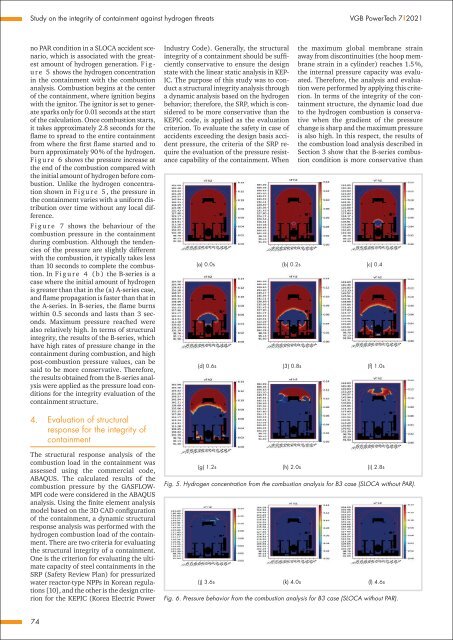VGB POWERTECH 7 (2021) - International Journal for Generation and Storage of Electricity and Heat
VGB PowerTech - International Journal for Generation and Storage of Electricity and Heat. Issue 7 (2021). Technical Journal of the VGB PowerTech Association. Energy is us! Optimisation of power plants. Thermal waste utilisation.
VGB PowerTech - International Journal for Generation and Storage of Electricity and Heat. Issue 7 (2021).
Technical Journal of the VGB PowerTech Association. Energy is us!
Optimisation of power plants. Thermal waste utilisation.
- No tags were found...
Create successful ePaper yourself
Turn your PDF publications into a flip-book with our unique Google optimized e-Paper software.
Study on the integrity <strong>of</strong> containment against hydrogen threats <strong>VGB</strong> PowerTech 7 l <strong>2021</strong><br />
no PAR condition in a SLOCA accident scenario,<br />
which is associated with the greatest<br />
amount <strong>of</strong> hydrogen generation. F i g -<br />
u r e 5 shows the hydrogen concentration<br />
in the containment with the combustion<br />
analysis. Combustion begins at the center<br />
<strong>of</strong> the containment, where ignition begins<br />
with the ignitor. The ignitor is set to generate<br />
sparks only <strong>for</strong> 0.01 seconds at the start<br />
<strong>of</strong> the calculation. Once combustion starts,<br />
it takes approximately 2.8 seconds <strong>for</strong> the<br />
flame to spread to the entire containment<br />
from where the first flame started <strong>and</strong> to<br />
burn approximately 90 % <strong>of</strong> the hydrogen.<br />
F i g u r e 6 shows the pressure increase at<br />
the end <strong>of</strong> the combustion compared with<br />
the initial amount <strong>of</strong> hydrogen be<strong>for</strong>e combustion.<br />
Unlike the hydrogen concentration<br />
shown in F i g u r e 5 , the pressure in<br />
the containment varies with a uni<strong>for</strong>m distribution<br />
over time without any local difference.<br />
F i g u r e 7 shows the behaviour <strong>of</strong> the<br />
combustion pressure in the containment<br />
during combustion. Although the tendencies<br />
<strong>of</strong> the pressure are slightly different<br />
with the combustion, it typically takes less<br />
than 10 seconds to complete the combustion.<br />
In F i g u r e 4 ( b ) the B-series is a<br />
case where the initial amount <strong>of</strong> hydrogen<br />
is greater than that in the (a) A-series case,<br />
<strong>and</strong> flame propagation is faster than that in<br />
the A-series. In B-series, the flame burns<br />
within 0.5 seconds <strong>and</strong> lasts than 3 seconds.<br />
Maximum pressure reached were<br />
also relatively high. In terms <strong>of</strong> structural<br />
integrity, the results <strong>of</strong> the B-series, which<br />
have high rates <strong>of</strong> pressure change in the<br />
containment during combustion, <strong>and</strong> high<br />
post-combustion pressure values, can be<br />
said to be more conservative. There<strong>for</strong>e,<br />
the results obtained from the B-series analysis<br />
were applied as the pressure load conditions<br />
<strong>for</strong> the integrity evaluation <strong>of</strong> the<br />
containment structure.<br />
Industry Code). Generally, the structural<br />
integrity <strong>of</strong> a containment should be sufficiently<br />
conservative to ensure the design<br />
state with the linear static analysis in KEP-<br />
IC. The purpose <strong>of</strong> this study was to conduct<br />
a structural integrity analysis through<br />
a dynamic analysis based on the hydrogen<br />
behavior; there<strong>for</strong>e, the SRP, which is considered<br />
to be more conservative than the<br />
KEPIC code, is applied as the evaluation<br />
criterion. To evaluate the safety in case <strong>of</strong><br />
accidents exceeding the design basis accident<br />
pressure, the criteria <strong>of</strong> the SRP require<br />
the evaluation <strong>of</strong> the pressure resistance<br />
capability <strong>of</strong> the containment. When<br />
the maximum global membrane strain<br />
away from discontinuities (the hoop membrane<br />
strain in a cylinder) reaches 1.5 %,<br />
the internal pressure capacity was evaluated.<br />
There<strong>for</strong>e, the analysis <strong>and</strong> evaluation<br />
were per<strong>for</strong>med by applying this criterion.<br />
In terms <strong>of</strong> the integrity <strong>of</strong> the containment<br />
structure, the dynamic load due<br />
to the hydrogen combustion is conservative<br />
when the gradient <strong>of</strong> the pressure<br />
change is sharp <strong>and</strong> the maximum pressure<br />
is also high. In this respect, the results <strong>of</strong><br />
the combustion load analysis described in<br />
Section 3 show that the B-series combustion<br />
condition is more conservative than<br />
(a) 0.0s (b) 0.2s (c) 0.4<br />
(d) 0.6s (3) 0.8s (f) 1.0s<br />
4. Evaluation <strong>of</strong> structural<br />
response <strong>for</strong> the integrity <strong>of</strong><br />
containment<br />
The structural response analysis <strong>of</strong> the<br />
combustion load in the containment was<br />
assessed using the commercial code,<br />
ABAQUS. The calculated results <strong>of</strong> the<br />
combustion pressure by the GASFLOW-<br />
MPI code were considered in the ABAQUS<br />
analysis. Using the finite element analysis<br />
model based on the 3D CAD configuration<br />
<strong>of</strong> the containment, a dynamic structural<br />
response analysis was per<strong>for</strong>med with the<br />
hydrogen combustion load <strong>of</strong> the containment.<br />
There are two criteria <strong>for</strong> evaluating<br />
the structural integrity <strong>of</strong> a containment.<br />
One is the criterion <strong>for</strong> evaluating the ultimate<br />
capacity <strong>of</strong> steel containments in the<br />
SRP (Safety Review Plan) <strong>for</strong> pressurized<br />
water reactor-type NPPs in Korean regulations<br />
[10], <strong>and</strong> the other is the design criterion<br />
<strong>for</strong> the KEPIC (Korea Electric Power<br />
(g) 1.2s (h) 2.0s (i) 2.8s<br />
Fig. 5. Hydrogen concentration from the combustion analysis <strong>for</strong> B3 case (SLOCA without PAR).<br />
(j) 3.6s (k) 4.0s (l) 4.6s<br />
Fig. 6. Pressure behavior from the combustion analysis <strong>for</strong> B3 case (SLOCA without PAR).<br />
74


















